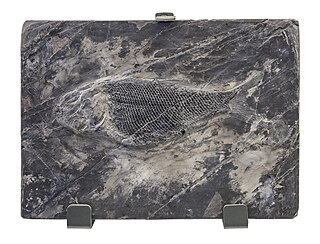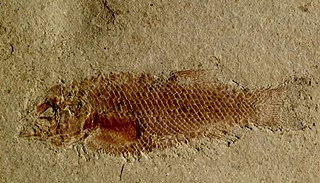Chongichthys is an extinct genus of prehistoric marine ray-finned fish that lived during the Oxfordian stage of the Late Jurassic epoch. It contains one species, C. dentatus from the Quebrada El Profeta of Chile. It is named after Chilean geologist Guillermo Chong.
Aphnelepis is an extinct genus of prehistoric freshwater ray-finned fish that lived during the Late Jurassic epoch. It contains a single species, A. australis, from the Talbragar River beds of New South Wales, Australia.

Atopocephala is an extinct genus of prehistoric freshwater ray-finned fish that lived during the Middle Triassic epoch. It contains a single species, A. watsoni from the Karoo Supergroup of South Africa. A potential indeterminate species was known from the Timezgadiouine Formation of Morocco, but is now considered an indeterminate actinopterygian.
Broughia is an extinct genus of marine holostean ray-finned fish that lived during the Induan age of the Early Triassic epoch in what is now Greenland. Fossils were found in the Wordie Creek Formation. A potential concurrent record is also known from Madagascar.

Brookvalia is an extinct genus of prehistoric freshwater ray-finned fish that lived during the Middle Triassic epoch.
Agecephalichthys is an extinct genus of prehistoric freshwater "palaeonisciform" ray-finned fish that lived during the Anisian age. It contains a single species, A. granulatus from the Hawkesbury Sandstone in what is now New South Wales, Australia.

Asialepidotus is an extinct genus of prehistoric marine ray-finned fish that lived during the Ladinian stage of the Middle Triassic epoch. It contains a single species, A. shingyiensis, from Guizhou, China.
Chichia is an extinct genus of freshwater ray-finned fish that lived during the Guadalupian epoch. It contains a single species, C. gracilis, known from the Bogda Shan of Xinjiang, China.

Acrolepis is an extinct genus of prehistoric marine bony fish that lived from the Famennian stage of the Devonian to the early Triassic epoch. Some species from the Early Triassic of Tasmania are also ascribed to Acrolepis.
Cheirodopsis is an extinct genus of prehistoric marine ray-finned fish that lived during the Viséan stage of the Mississippian epoch. It contains a single species, C. geikiei from what is now Glencartholm, Scotland.
Aphelolepis is an extinct genus of prehistoric ginglymodian bony fish. It contains one species, A. delpi, that lived during the Ladinian age of the Middle Triassic epoch in what is now Franconia, Germany. It is generally considered a semionotiform.

Besania is an extinct genus of prehistoric marine ray-finned fish that lived during the Anisian and Ladinian ages of the Middle Triassic epoch in what is now southern/southeastern Switzerland and northern Italy. Fossils were recovered from the Besano Formation of Monte San Giorgio area and the Prosanto Formation of canton Graubünden, Switzerland.

Acentrophorus is an extinct genus of prehistoric freshwater and marine ray-finned fish from the Roadian to the Wuchiapingian of England, Germany (Kupferschiefer), Italy and Russia. There may also be a Triassic occurrence in Australia.
Alleiolepis is an extinct genus of prehistoric bony fish, which lived during the Ladinian age of the Middle Triassic epoch in what is now Franconia, Germany. It is generally considered a semionotiform. It was first named Leiolepis, but because this genus name is preoccupied by an extant lizard, the genus name of the Triassic fish was changed to Aleiolepis.

Allolepidotus is an extinct genus of prehistoric marine neopterygian ray-finned fish from the Middle Triassic epoch of what is now Italy, Spain, and Switzerland. It was formerly referred to the halecomorph order Panxianichthyiformes, but is now thought to be a member of the Ionoscopiformes.
Isadia is an extinct genus of prehistoric freshwater ray-finned fish from the order Eurynotoidiformes. It is known from the Permian of European Russia. The genus Amblypterina is partially considered a junior synonym of both Isadia and Kichkassia.
Boreolepis is an extinct genus of prehistoric marine ray-finned fish that lived from the Late Kungurian to the Wuchiapingian of the Permian period. It inhabited the high northern latitudes in what is now Greenland and European Russia.

Brembodus is an extinct marine pycnodontid fish, the type genus of the family Brembodontidae. It contains a single species, B. ridens, known from the Late Triassic Calcare di Zorzino formation of Cene, Italy.
Ceramurus is an extinct genus of prehistoric marine ray-finned fish from the Late Jurassic. It contains a single species, C. macrocephalus from the Purbeck Group of England.
Chuhsiungichthys is an extinct genus of ichthyodectiform ray-finned fish that lived in freshwater environments in what is now Yunnan, China, and Kyushu, Japan during the Cretaceous. It differs from its sister genus, Mesoclupea, primarily by having a comparatively more anteriorly-placed dorsal fin.












